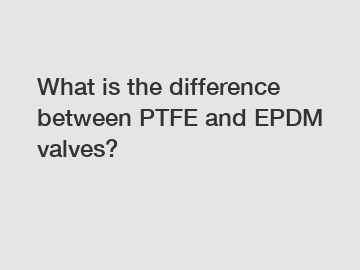What is the difference between PTFE and EPDM valves?
What is the difference between PTFE and EPDM valves? This question often arises when discussing valve materials for industrial applications. In this article, we will delve into the composition, properties, and significance of these two common valve materials.
PTFE, or polytetrafluoroethylene, is a synthetic fluoropolymer that is known for its exceptional chemical resistance and non-stick properties. It is widely used in various industries ranging from chemical processing to food and beverage because of its inertness and durability. On the other hand, EPDM, or ethylene propylene diene monomer, is a synthetic rubber that exhibits excellent resistance to weathering, aging, and ozone. It is commonly used in applications where flexibility and good sealing properties are required.
The key difference between PTFE and EPDM valves lies in their chemical composition and physical properties. PTFE is a solid, whereas EPDM is a rubber material. As a solid material, PTFE has a low coefficient of friction, which makes it suitable for applications where smooth and low-torque operation is desired. It also has a wide temperature range, from -200°C to 260°C, allowing it to withstand extreme temperatures. EPDM, being a rubber material, offers good elasticity and flexibility, enabling it to provide excellent sealing performance even under varying pressures and temperatures.

Furthermore, PTFE exhibits exceptional chemical resistance to a broad range of corrosive substances, including acids, bases, and solvents. This makes PTFE valves highly suitable for handling aggressive chemicals in chemical processing plants and laboratories. On the other hand, EPDM valves are particularly suited for applications involving water, steam, and mild chemicals due to their excellent resistance to ozone and weathering.
The significance of these differences becomes evident when considering the specific requirements of each application. Choosing the right valve material is crucial to ensuring optimal performance, efficiency, and longevity. For instance, in a chemical processing plant, where corrosive chemicals are involved, the use of PTFE valves can prevent damage and ensure safe operation. Conversely, using EPDM valves in applications involving water or steam can provide excellent sealing capabilities, reducing the risk of leaks and optimizing overall system performance.
In conclusion, the difference between PTFE and EPDM valves lies in their composition, properties, and applications. PTFE offers exceptional chemical resistance and temperature capabilities, making it suitable for corrosive environments. EPDM, on the other hand, provides good elasticity and sealing properties, making it ideal for applications involving water and steam. Considering the specific requirements of each application is crucial in ensuring the right valve material is chosen, leading to improved performance, reliability, and safety.
For more dispensing closure, dispensing closure, dispensing closureinformation, please contact us. We will provide professional answers.
161
0
0


Comments
All Comments (0)